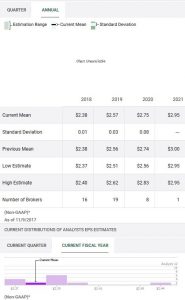Contents
 Summary
Summary
- This Paychex stock analysis is based on Q1 2018 result as at August 31, 2017.
- Paychex is a leading provider of payroll processing, human resources and benefits services.
- It is expensive at current the current price of ~$64.50.
- A price in the low $50s or below is more reasonable and is not totally out of the realm of possibility.
Introduction
My first Paychex (NASDAQ: PAYX) article was posted December 23, 2016. This was followed up with an April 24, 2017 post in which I indicated I sold PAYX shares which were held in a Registered Education Savings Plan. While I fully intended to reinvest the sale proceeds by re-acquiring PAYX shares, this did not materialize as I ended up acquiring shares in other companies.
I still intend to re-acquire PAYX shares at some stage because it is a wonderful company with a great business model. With this in mind I provide my current thoughts on PAYX.
Risks
Investing in any company comes with risks. Readers are encouraged to review the “ Risk Factors” section found under Item 1A in PAYX’s 10-K as at May 31, 2017.
Q1 2018 Results
On October 3, 2017, PAYX released its Q1 2018 results. It continues to maintain a remarkably pristine balance sheet with virtually no debt other than ~$5B in “Client Fund Obligations” which is more than offset by “Funds Held for Clients”.
Unlike many other companies I have analyzed which have grown by acquisition and which have significant “Intangible Assets” and “Goodwill” on their balance sheets, the amounts reflected for the two asset classes are relatively reasonable.
The $0.041B uptick in to $0.698B in Goodwill subsequent to PAYX’s May 31, 2017 fiscal year end is attributed to the August 2017 closing of HR Outsourcing Holdings, Inc. (“HROI”) and all of its operating subsidiaries; HROI is a national professional employer organization that provides HR solutions to small- and medium-sized businesses in more than 35 states.
PAYX’s Q1 2018 highlights and financial results can be found here. Select images from this presentation are provided below.
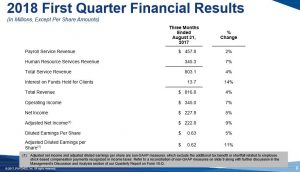
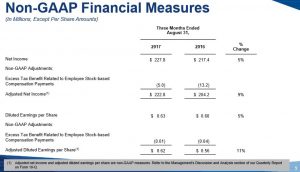
 Source: PAYX Q1 2018 Highlights and Financial Results
Source: PAYX Q1 2018 Highlights and Financial Results
In its presentation PAYX noted that:
- Q1 2017 results were favorably impacted from tailwinds related to the Affordable Care Act. Q1 2018 results did not have such benefit;
- PAYX holds clients’ funds in trust and benefits in a rising interest rate environment. The June 2017 25 bps increase in the Fed Funds rate (1% increased to 1.25%) is to PAYX’s advantage.
Fiscal 2018 versus Fiscal 2017 Outlook
I thought it would be beneficial to provide the current year’s and last year’s outlook for comparison purposes.
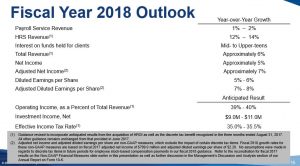 Source: PAYX Q1 2018 Highlights and Financial Results
Source: PAYX Q1 2018 Highlights and Financial Results
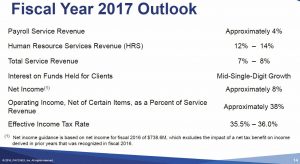 The National Federation of Independent Business confidence indicators point to small business momentum but regulatory uncertainty could stifle this momentum. If corporate tax reform is implemented I suspect PAYX would benefit in a reduction from its ~35% current tax rate.
The National Federation of Independent Business confidence indicators point to small business momentum but regulatory uncertainty could stifle this momentum. If corporate tax reform is implemented I suspect PAYX would benefit in a reduction from its ~35% current tax rate.
PAYX also faces a possible setback depending on the outcome of the Department of Labor’s Overtime Rule. If enacted it could have a negative impact on the demand for Human Capital Management solutions. There is also some uncertainty at the client level pertaining to new signings from the Affordable Care Act and the recent hurricanes in Texas and Florida could negatively impact PAYX’s sales results.
While rising interest rates will benefit PAYX in that it holds several billion in client funds, it remains to be seen what impact further interest rate increases could have on PAYX’s core client base: small – medium size businesses.
Dividend, Dividend Yield, and Dividend Payout Ratio
PAYX’s quarterly dividend is currently $0.50 with the next dividend payable November 15, 2017 to shareholders of record as at November 1, 2017.Based on the current stock price of $64.57 we get a ~3.1% dividend yield.
If you are a Canadian resident, please be cognizant that owning PAYX in a non-registered account is going to result in a 15% withholding tax haircut so your dividend yield will be ~2.64%.
PAYX’s compound annual dividend growth rate for 2008 – 2017 is reflected below.
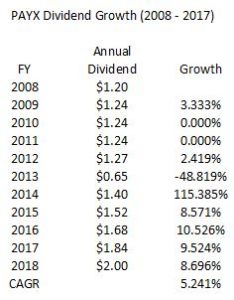 Readers should keep in mind that dividends are historically paid in August, November, February, and May. In fiscal 2013, however, the dividends that would typically have been paid in February 2013 and May 2013 were accelerated and paid in December 2012. This explains the dramatic changes in growth reflected above.
Readers should keep in mind that dividends are historically paid in August, November, February, and May. In fiscal 2013, however, the dividends that would typically have been paid in February 2013 and May 2013 were accelerated and paid in December 2012. This explains the dramatic changes in growth reflected above.
The nature of PAYX’s business and the manner in which the company is operated results in strong free cash flow (even during the Financial Crisis). Despite maintaining a dividend payout ratio in the ~80% range, management has been able to finance growth without the need to take on debt.
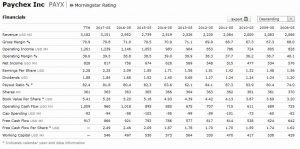 Source: Morningstar
Source: Morningstar
Stock Price Performance Relative to Peer Group
Had you invested $100 in PAYX common stock on May 31, 2012 and reinvested all subsequently received dividends, your 5 year cumulative return would have fared relative to the S&P 500 Index and a Peer Group Index as reflected below.
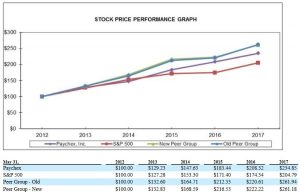 Source: PAYX 2017 10-K
Source: PAYX 2017 10-K
Management’s reasons for changing the members of PAYX’s Peer Group can be found on page 14 of 85 in the 2017 10-K.
Valuation
PAYX reported adjusted diluted EPS of $2.20 in FY2017. The forecast for FY2018 is a 7 – 8% increase (~$2.35 – ~2.38) as reflected in the Fiscal 2018 versus Fiscal 2017 Outlook section above.
The current mean estimate from multiple brokers is $2.38.
At the time this article is being composed, PAYX is trading at $64.57. If I use the mid-point of PAYX’s FY2018 forecast ($2.365), PAYX is trading at a forward PE of ~27.3. This level is too high for my liking.
I provide the following historical valuation levels for comparison purposes.
Paychex Stock Analysis – Final Thoughts
I originally acquired PAYX in July 2009 at ~$25. Not only was the PE level at that time much lower than the current level but the FX rate was CDN$1.1705 to USD$1. As I compose this article, the FX rate is ~CDN1.2688 to USD$1.
Despite the rate issue described above and the 15% withholding tax hit on dividends received from US companies, I would still consider reacquiring PAYX. My reasoning is that it is a well run business, I like the strong balance sheet, and I see growth potential.
I am, however, very reluctant to acquire PAYX shares at the current price and am prepared to exercise patience if I want to acquire shares at ~22 times the mid-point of PAYX’s FY2018 forecast ($2.365).
At ~$52/share that would be roughly a $12/share reduction from current levels. This is not totally unrealistic as PAYX retraced to ~$54 in the first half of August 2017. Unfortunately, much was happening at my end during that period of time so I missed my opportunity.
I keep hoping for a major market correction. I don’t know when it will happen but when it does I hope to go shopping.
I wish you much success on your journey to financial freedom.
Thanks for reading!
Note: I sincerely appreciate the time you took to read this post. As always, please leave any feedback and questions you may have in the “Contact Me Here” section to the right.
Disclaimer: I have no knowledge of your individual circumstances and am not providing individualized advice or recommendations. I encourage you not to make any investment decision without conducting your own research and due diligence. You should also consult your financial advisor about your specific situation.
Disclosure: I currently do not hold a position in PAYX and do not intend to initiate a position within the next 72 hours unless the price drops to my target levels.
I wrote this article myself and it expresses my own opinions. I am not receiving compensation for it and have no business relationship with any company whose stock is mentioned in this article.


